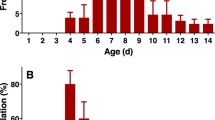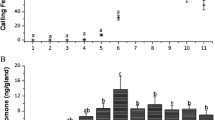Abstract
Males of the redbanded leafroller,Argyrotaenia velutinana (Walker) (Lepidoptera: Tortricidae), were studied for their behavioral responses in laboratory olfactometers and in the field to the 3 components of the female-produced sex pheromone:cis-11-tetradecenyl acetate (c11–14∶Ac),trans-11-tetradecenyl acetate (t11–14∶Ac), and dodecyl acetate (12∶Ac). Dodecyl acetate, when evaporated with c11–14∶Ac (8%trans) in the field, modified the behavior of feral males nearby the chemical source, causing an increase in the frequency of landing and close approach to the pheromone dispenser. Apparently, an inflight behavioral modification concerning landing or not landing occurs within 60 cm of the source and is mediated by 12∶Ac. In laboratory olfactometers, c11–14∶Ac (8%trans) demonstrated a lower threshold for male activation than pure c11- and t11–14∶Ac and blends of the two isomers. Additionally, over a wide range of dosages, males responded with optimum wing-fanning response to c11–14∶Ac (8%trans) compared to pure c11–14∶Ac, c11–14:Ac (30%trans), and pure t11–14∶Ac, suggesting that thecis∶trans ratio rather than absolute amounts of either isomer, is a crucial factor in eliciting male response. When presented with c11–14∶Ac (8%trans) (1∶1), dodecyl acetate caused a significant prolongation of wing-fanning over c11–14∶Ac (8%trans) alone and resulted in a greater percentage of males moving upwind to the source. Since the increase in wing-fanning and orientation occurred at higher concentrations of the 3-component mixture, the effect of 12∶Ac in the laboratory may reflect the close-range role of 12∶Ac in the field.
Similar content being viewed by others

References
Bartell, R.J., andRoelofs, W.L. 1973. Evidence for natural secondary compounds which modify the response of males of the redbanded leafroller to female sex pheromone.Ann. Entomol. Soc. Am. 66:481–483.
Cardé, R.T., Baker, T.C., andRoelofs, W.L. 1975a. Behavioural role of individual components of a multichemical attractant system in the Oriental fruit moth.Nature 253:348, 349.
Cardé, R.T., Baker, T.C., andRoelofs, W.L. 1975b. Ethological function of components of a sex attractant system for Oriental fruit moth males,Grapholitha molesta (Lepidoptera: Tortricidae).J. Chem. Ecol. 1:475–491.
Cardé, R.T., Comeau, A., Baker, T.C., andRoelofs, W.L. 1975c. Moth mating periodicity: temperature regulates the circadian gate.Experientia 31:46–48.
Comeau, A., Cardé, R.T., andRoelofs, W.L. 1976. Relationship of ambient temperatures to diel periodicities of sex attraction in six species of Lepidoptera.Can. Entomol. 108:415–418.
Glass, E.H., andHervey, G.E.R. 1962. Continuous rearing of the redbanded leafroller,Argyrotaenia velutinana.J. Econ. Entomol. 55:336–340.
Glass, E.H., Roelofs, W.L., Arm, H., andComeau, A. 1970. Sex pheromone trapping of redbanded leafroller moths and development of a long-lasting polyethylene wick.J. Econ. Entomol. 63:370–373.
Klun, J.A., Chapman, O.L., Mattes, K.C., Wojtkowski, P.W., Beroza, M., andSonnet, P.E. 1973. Insect sex pheromones: minor amount of opposite geometrical isomer critical to attraction.Science 181:661–663.
O'Connell, R.J. 1972. Responses of olfactory receptors to the sex attractant, its synergist and inhibitor in the redbanded leafroller, pp. 180–186,in D. Schneider (ed.), Olfaction and Taste, Vol. IV. Wissenschaftliche GmbH, Stuttgart.
O'Connell, R.J. 1975. Olfactory receptor responses to sex pheromone components in the redbanded leafroller moth.J. Gen. Physiol. 65:179–205.
Roelofs, W.L., andArn, H. 1968. Sex attractant of the redbanded leafroller moth.Nature London 219:513.
Roelofs, W.L., andComeau, A. 1968. Sex pheromone perception.Nature 220:600, 601.
Roelofs, W.L., andComeau, A. 1971. Sex pheromone perception: synergists and inhibitors for the redbanded leafroller attractant.J. Insect Physiol. 17:435–448.
Roelofs, W.L., andFeng, K.-C. 1967. Isolation and bioassay of the sex pheromone of the redbanded leafroller,Argyrotaenia velutinana (Lepidoptera: Tortricidae).Ann. Entomol. Soc. Am. 60:1199–1203.
Roelofs, W., Hill, A., andCardé, R. 1975. Sex pheromone of the redbanded leafroller,Argyrotaenia velutinana (Lepidoptera: Tortricidae).J. Chem. Ecol. 1:83–89.
Shorey, H.H., andHale, R.L. 1965. Mass-rearing of the larvae of nine noctuid species on a simple artificial medium.J. Econ. Entomol. 58:522–524.
Sower, L.L., Vick, K.W., andLong, J.S. 1973. Isolation and preliminary biological studies of the female-produced sex pheromone ofSitotroga cerealella (Lepidoptera: Gelechiidae).Ann. Entomol. Soc. Am. 66:184–187.
Author information
Authors and Affiliations
Rights and permissions
About this article
Cite this article
Baker, T.C., Cardé, R.T. & Roelofs, W.L. Behavioral responses of maleArgyrotaenia velutinana (Lepidoptera: Tortricidae) to components of its sex pheromone. J Chem Ecol 2, 333–352 (1976). https://doi.org/10.1007/BF00988281
Received:
Revised:
Issue Date:
DOI: https://doi.org/10.1007/BF00988281



